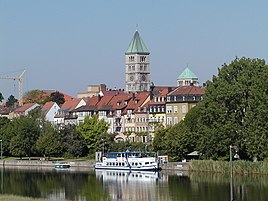Fischerrain
|
Fischerrain
District of Schweinfurt
Coordinates: 50 ° 2 ′ 32 ″ N , 10 ° 13 ′ 56 ″ E
|
|
|---|---|
| Height : | 215 m |
| Area : | 2.4 ha |
| Postal code : | 97421 |
| Area code : | 09721 |
|
Fischerrain with Main
|
|
The Fischerrain (Schweinfurterisch: Fischerree , place name: am Fischerrain ) is a district of the independent city of Schweinfurt and part of the old town . The former fishing settlement on the Main , of unknown age and origin, with finds from the first millennium BC. Was soon incorporated into the imperial city of Schweinfurt .
location
The Fischerrain is located in the southwest corner of the old town, at a right angle between the Main and the Old Cemetery. The Bamberg – Schweinfurt Hbf railway line runs between the Main and Fischerrain . Not far to the west of Fischerrain is the Schweinfurt Mitte DB stop .
The Fischerrain borders (clockwise from the north) on Schultesstraße (formerly: Steinweg ), Albrecht-Dürer-Platz (formerly: Holzmarkt ), the eastern part of Fischerrain Street (formerly the inner city moat), the railway line with the parallel Gutermann-Promenade (once Leinritt am Main) and the old cemetery.
history
First millennium BC Chr.
Before the turn of the century, the Fischerrain was already settled. During excavations in 2016, finds from the Hallstatt period (800 to 450 BC) and the Latène period (450 BC to the turn of the century) were found.
Middle Ages and early modern times
The excavations also gave much evidence of a medieval artisan settlement, with finds of pottery, bricks and bones. The Fischerrain was originally an independent settlement and was mentioned as a fishing settlement as early as 1383 in the annals of Nikolaus Sprenger. It does not belong to the area of the structural expansion of the city, but is still located directly outside the first wall ring with the inner city gates. The origin and time of the annexation of the fishing settlement to the imperial city of Schweinfurt are unknown. The settlement lay outside the city wall at least until the city was expanded from 1437 and had its own mayor even after that . Since then, the quarter with the Fischertor has had its own entrance to the city, through which the fishermen had unimpeded access to the Main at any time of the day, without a gate lock or blocking fee.

On the western edge of the quarter, at the old cemetery, lies the alley An den Brennöfen , which was almost completely destroyed in the last war and named after the stoves used by the Häfner . Here was a Carmelite monastery, which was destroyed in the Second Ruin of the City in 1553 and finally removed in 1560 . The Schweinfurt local researcher Hubert Gutermann (1892–1974) lived in the corner house Mainaussicht 63 . He wrote the classic textbook Alt Schweinfurt .
Ordinari shipping
The fishermen also practiced shipping on the Main. Of the 58 professional fishermen still resident in 1846, seven operated the Ordinari shipping . In 1738 an ordinary was introduced to transport goods to Würzburg , in 1773 to Bamberg and in 1843 through the Ludwig-Danube-Main Canal to Nuremberg and Regensburg , and in the opposite direction to Frankfurt am Main . In the Bavarian original cadastre from 1808, in addition to a predominantly military port on the Main Island Bleichrasen, a civil port is shown to the west of the fishing area at today's Heilig-Geist-Kirche . It was completely filled in again and built over (see also Schweinfurt Harbor, Modern Times ).
Fish houses and restaurants
Until the early 20th century , when the city was still an important wine town (see: Schweinfurt, Viticulture ), the Fischerrain had numerous fish shops, wine restaurants and breweries in a typical Franconian mix.
- "The community with the nearby river, which consisted of fishermen, bakers, bakers, stoners, dyers, beer and wine shops with fish bakeries and other craftsmen, had a life of its own for a long time."
Today the fish shops Stein and Dittmar and two restaurants still exist. The traditional, smaller wine tavern Gößwein , which was first mentioned in a document in 1816, was Schweinfurt's leading restaurant in the post-war decades . Today it is continued as the Hess wine restaurant .
Breweries
There were a total of three breweries on Fischerrain, all of which were located around Gasse Fischersteig and no longer exist. The headquarters of the Hagenmeyer brewery , which closed elsewhere in 1988. The Rauschert / Ebersberger brewery founded in 1878 . There was also the Zum Rossknecht brewery in the Albrecht Dürer Center in the 1980s .
present
The townscape of the Fischerrain has been dominated by the Main since the beginning of the 20th century by the Heilig-Geist-Kirche , which, however, is outside the quarter, north of Schultesstrasse.
The Fischerrain was carefully renovated towards the end of the 20th century and vacant lots on the banks of the Main due to the war were closed. One of the last big gaps in the war in the old town, in the west of the Fischerrain, An den Brennöfen , was also closed and completed in 2020.
Web links
Individual evidence
- ↑ Measured in the BayernAtlas , area excluding the old cemetery
- ↑ mainpost.de: Tief Keller am Fischerrain, November 8, 2016. Accessed April 30, 2020 .
- ↑ a b c Paul Ultsch: Back then in Schweinfurt . Volume 1: When the city wall was still a boundary . Book and Idea Publishing GmbH, Schweinfurt, ISBN 3-9800480-1-2 , p. 72
- ↑ a b Peter Hofmann: schweinfurtfuehrer.de
- ↑ schweinfurtfuehrer.de accessed on January 10, 2016
- ↑ 1st prize in the architectural competition for development on the kilns. Retrieved March 2, 2017 .



